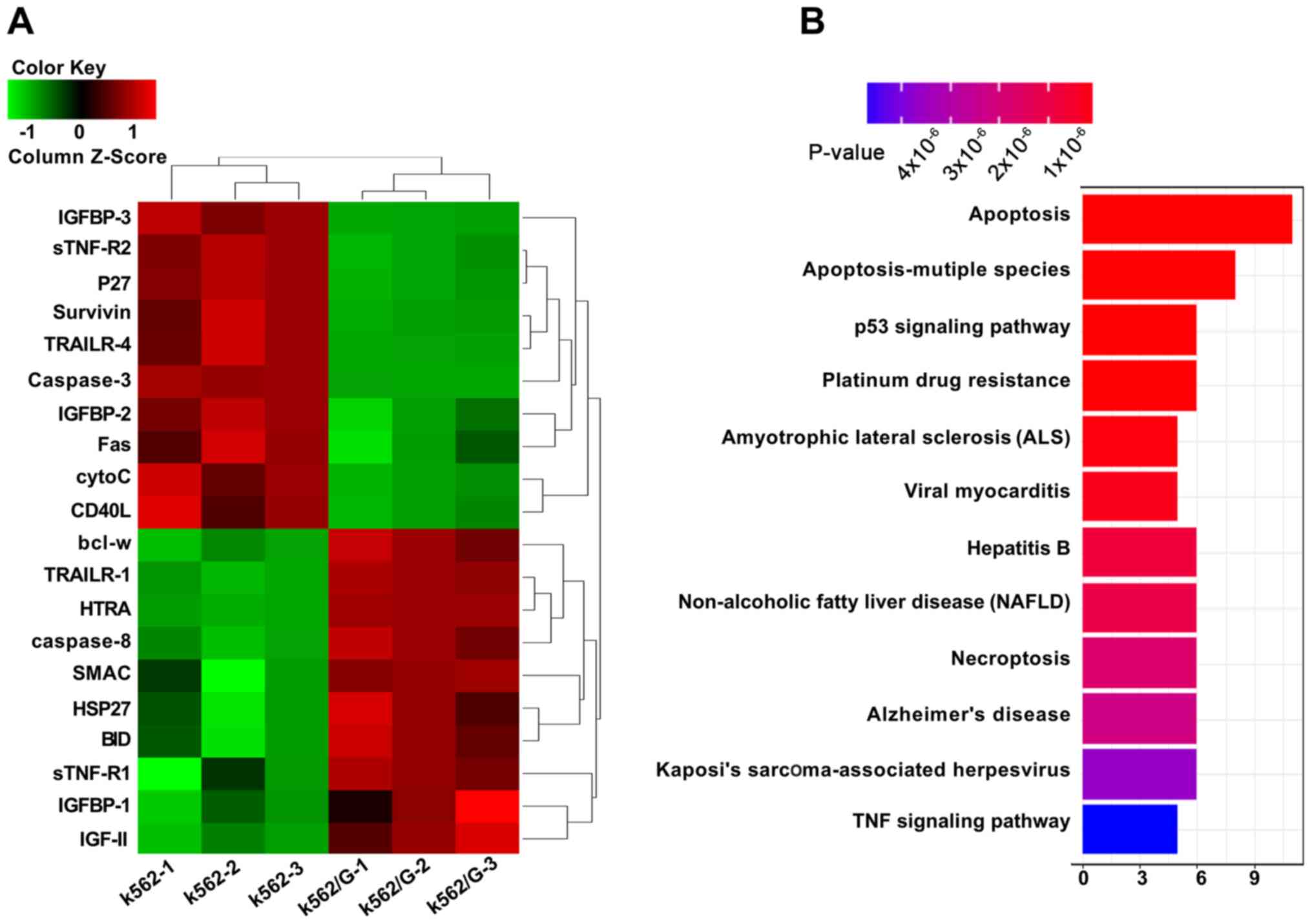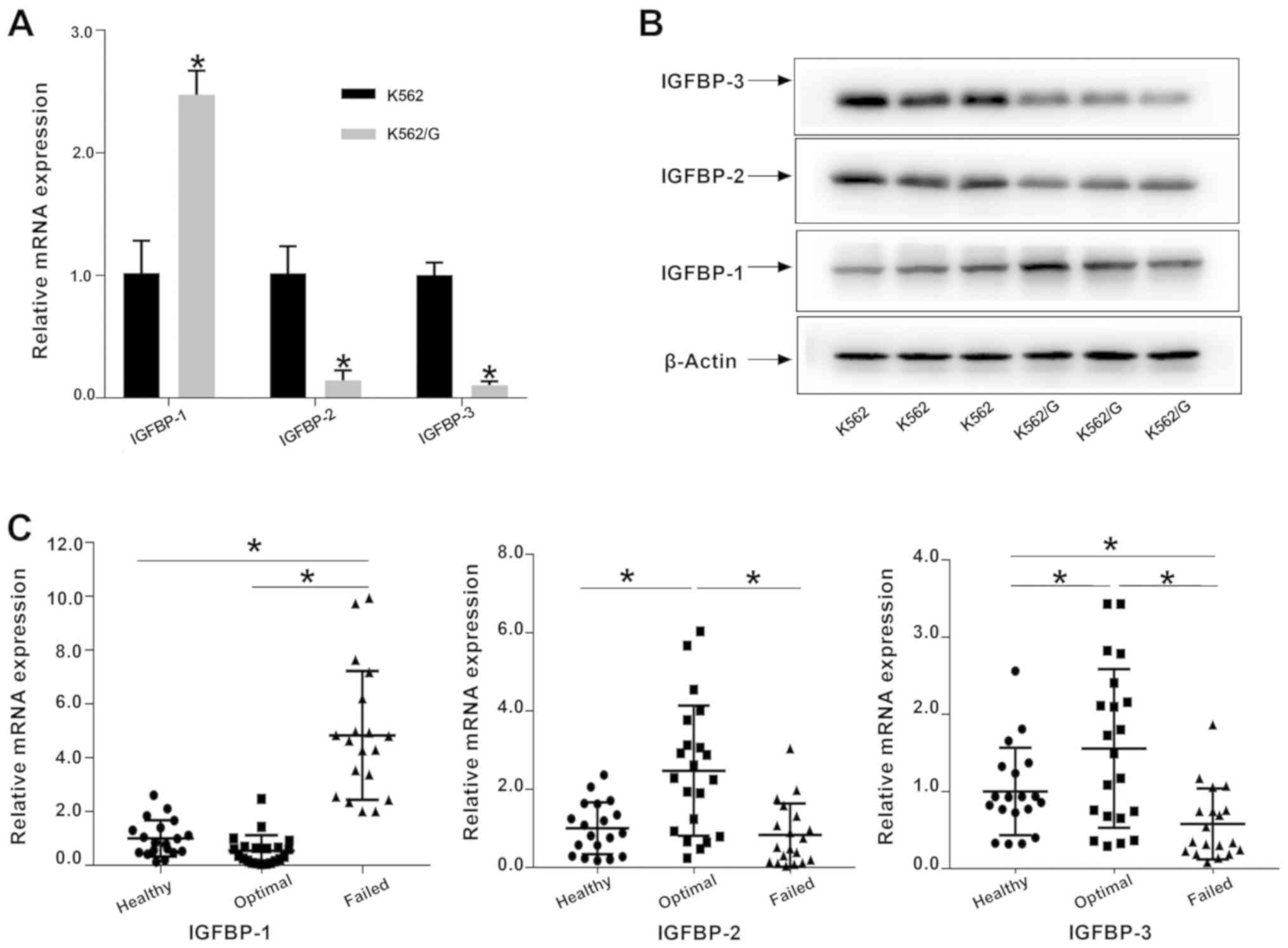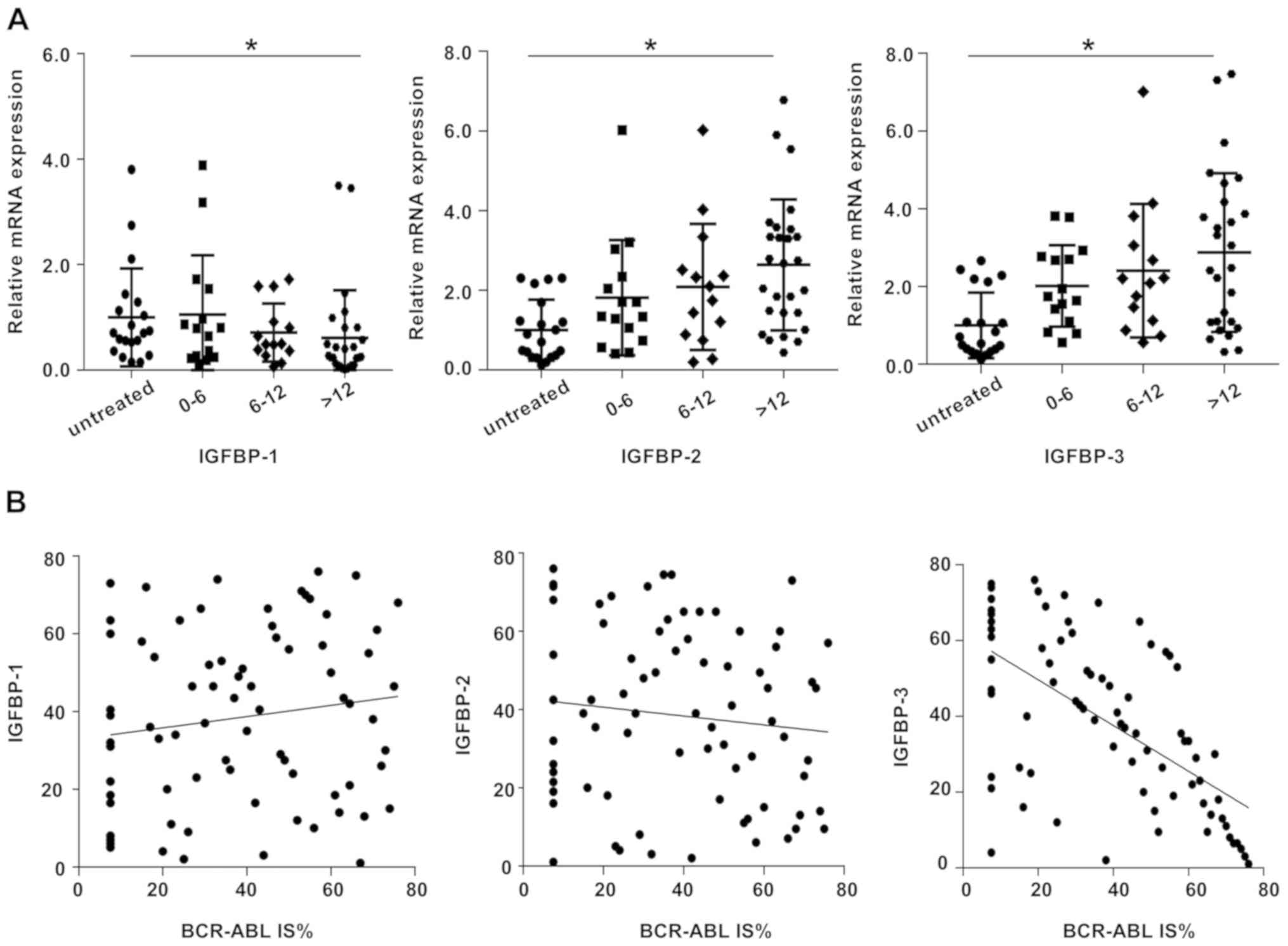|
1
|
Radich JP, Deininger M, Abboud CN, Altman
JK, Berman E, Bhatia R, Bhatnagar B, Curtin P, DeAngelo DJ, Gotlib
J, et al: Chronic myeloid leukemia, version 1.2019, NCCN clinical
practice guidelines in oncology. J Natl Compr Canc Netw.
16:1108–1135. 2018. View Article : Google Scholar : PubMed/NCBI
|
|
2
|
Pan P, Wang L, Wang Y, Shen L, Zheng P, Bi
C, Zhang A, Lv Y, Xue Z, Sun M, et al: Systematic review and
meta-analysis of-new-generation tyrosine kinase inhibitors versus
imatinib for newly diagnosed chronic myeloid leukemia. Acta
Haematol. 1–13. 2019.(Epub ahead of print). View Article : Google Scholar
|
|
3
|
Aladağ E and Haznedaroğlu İC: Current
perspectives for the treatment of chronic myeloid leukemia. Turk J
Med Sci. 49:1–10. 2019.PubMed/NCBI
|
|
4
|
Radich JP: The biology of CML blast
crisis. Hematology Am Soc Hematol Educ Program. 384–391. 2007.
View Article : Google Scholar : PubMed/NCBI
|
|
5
|
Sillaber C, Mayerhofer M, Agis H, Sagaster
V, Mannhalter C, Sperr WR, Geissler K and Valent P: Chronic myeloid
leukemia: Pathophysiology, diagnostic parameters, and current
treatment concepts. Wien Klin Wochenschr. 115:485–504. 2003.
View Article : Google Scholar : PubMed/NCBI
|
|
6
|
Anstrom KJ, Reed SD, Allen AS, Glendenning
GA and Schulman KA: Long-term survival estimates for imatinib
versus interferon-alpha plus low-dose cytarabine for patients with
newly diagnosed chronic-phase chronic myeloid leukemia. Cancer.
101:2584–2592. 2004. View Article : Google Scholar : PubMed/NCBI
|
|
7
|
Rossari F, Minutolo F and Orciuolo E:
Past, present, and future of Bcr-Abl inhibitors: From chemical
development to clinical efficacy. J Hematol Oncol. 11:842018.
View Article : Google Scholar : PubMed/NCBI
|
|
8
|
Puche JE and Castilla-Cortázar I: Human
conditions of insulin-like growth factor-I (IGF-I) deficiency. J
Transl Med. 10:2242012. View Article : Google Scholar : PubMed/NCBI
|
|
9
|
Yakar S and Isaksson O: Regulation of
skeletal growth and mineral acquisition by the GH/IGF-1 axis:
Lessons from mouse models. Growth Horm IGF Res. 28:26–42. 2016.
View Article : Google Scholar : PubMed/NCBI
|
|
10
|
Pais RS, Moreno-Barriuso N,
Hernández-Porras I, López IP, De Las Rivas J and Pichel JG:
Transcriptome analysis in prenatal IGF1-deficient mice identifies
molecular pathways and target genes involved in distal lung
differentiation. PLoS One. 8:e830282013. View Article : Google Scholar : PubMed/NCBI
|
|
11
|
Kelly GM, Buckley DA, Kiely PA, Adams DR
and O'Connor R: Serine phosphorylation of the insulin-like growth
factor I (IGF-1) receptor C-terminal tail restrains kinase activity
and cell growth. J Biol Chem. 287:28180–28194. 2012. View Article : Google Scholar : PubMed/NCBI
|
|
12
|
Firth SM and Baxter RC: Cellular actions
of the insulin-like growth factor binding proteins. Endocr Rev.
23:824–854. 2002. View Article : Google Scholar : PubMed/NCBI
|
|
13
|
Takahashi SI: IGF research 2016–2018.
Growth Horm IGF Res. 48-49:65–69. 2019. View Article : Google Scholar : PubMed/NCBI
|
|
14
|
Alvino CL, Ong SC, McNeil KA, Delaine C,
Booker GW, Wallace JC and Forbes BE: Understanding the mechanism of
insulin and insulin-like growth factor (IGF) receptor activation by
IGF-II. PLoS One. 6:e274882011. View Article : Google Scholar : PubMed/NCBI
|
|
15
|
Li H, Batth IS, Qu X, Xu L, Song N, Wang R
and Liu Y: IGF-IR signaling in epithelial to mesenchymal transition
and targeting IGF-IR therapy: Overview and new insights. Mol
Cancer. 16:62017. View Article : Google Scholar : PubMed/NCBI
|
|
16
|
King H, Aleksic T, Haluska P and Macaulay
VM: Can we unlock the potential of IGF-1R inhibition in cancer
therapy? Cancer Treat Rev. 40:1096–1105. 2014. View Article : Google Scholar : PubMed/NCBI
|
|
17
|
Jiang X, Cheng Y, Hu C, Zhang A, Ren Y and
Xu X: MicroRNA-221 sensitizes chronic myeloid leukemia cells to
imatinib by targeting STAT5. Leuk Lymphoma. 60:1709–1720. 2019.
View Article : Google Scholar : PubMed/NCBI
|
|
18
|
Chinese Society of Hematology, Chinese
Medical Association, . The guidelines for diagnosis and treatment
of chronic myelogenous leukemia in China (2016 edition). Zhonghua
Xue Ye Xue Za Zhi. 37:633–639. 2016.(In Chinese). PubMed/NCBI
|
|
19
|
Yu G, Wang LG, Han Y and He QY:
clusterProfiler: An R package for comparing biological themes among
gene clusters. OMICS. 16:284–287. 2012. View Article : Google Scholar : PubMed/NCBI
|
|
20
|
Cheng Y, Hao Y, Zhang A, Hu C, Jiang X, Wu
Q and Xu X: Persistent STAT5-mediated ROS production and
involvement of aberrant p53 apoptotic signaling in the resistance
of chronic myeloid leukemia to imatinib. Int J Mol Med. 41:455–463.
2018.PubMed/NCBI
|
|
21
|
Livak KJ and Schmittgen TD: Analysis of
relative gene expression data using real-time quantitative PCR and
the 2(-Delta Delta C(T)) method. Methods. 25:402–408. 2001.
View Article : Google Scholar : PubMed/NCBI
|
|
22
|
Team RC: R: A language and environment for
statistical computing. R Foundation for Statistical Computing.
(Vienna, Austria). http://www.R-project.org/2013.
|
|
23
|
Branford S and Hughes T: Detection of
BCR-ABL mutations and resistance to imatinib mesylate. Methods Mol
Med. 125:93–106. 2006.PubMed/NCBI
|
|
24
|
Yang M, Xi Q, Jia W and Wang X:
Structure-based analysis and biological characterization of
imatinib derivatives reveal insights towards the inhibition of
wild-type BCR-ABL and its mutants. Bioorg Med Chem Lett.
29:1267582019. View Article : Google Scholar : PubMed/NCBI
|
|
25
|
El Fakih R, Chaudhri N, Alfraih F, Rausch
CR, Naqvi K and Jabbour E: Complexity of chronic-phase CML
management after failing a second-generation TKI. Leuk Lymphoma.
1–12. 2019.(Epub ahead of print). View Article : Google Scholar : PubMed/NCBI
|
|
26
|
Jabbour E, Kantarjian H and Cortes J: Use
of second- and third-generation tyrosine kinase inhibitors in the
treatment of chronic myeloid leukemia: An evolving treatment
paradigm. Clin Lymphoma Myeloma Leuk. 15:323–334. 2015. View Article : Google Scholar : PubMed/NCBI
|
|
27
|
Branford S, Rudzki Z, Walsh S, Parkinson
I, Grigg A, Szer J, Taylor K, Herrmann R, Seymour JF, Arthur C, et
al: Detection of BCR-ABL mutations in patients with CML treated
with imatinib is virtually always accompanied by clinical
resistance, and mutations in the ATP phosphate-binding loop
(P-loop) are associated with a poor prognosis. Blood. 102:276–283.
2003. View Article : Google Scholar : PubMed/NCBI
|
|
28
|
Fenouille N, Puissant A, Dufies M, Robert
G, Jacquel A, Ohanna M, Deckert M, Pasquet JM, Mahon FX, Cassuto
JP, et al: Persistent activation of the Fyn/ERK kinase signaling
axis mediates imatinib resistance in chronic myelogenous leukemia
cells through upregulation of intracellular SPARC. Cancer Res.
70:9659–9670. 2010. View Article : Google Scholar : PubMed/NCBI
|
|
29
|
Elias MH, Baba AA, Husin A, Sulong S,
Hassan R, Sim GA, Abdul Wahid SF and Ankathil R: HOXA4 gene
promoter hypermethylation as an epigenetic mechanism mediating
resistance to imatinib mesylate in chronic myeloid leukemia
patients. Biomed Res Int. 2013:1297152013. View Article : Google Scholar : PubMed/NCBI
|
|
30
|
Balabanov S, Gontarewicz A, Keller G,
Raddrizzani L, Braig M, Bosotti R, Moll J, Jost E, Barett C, Rohe
I, et al: Abcg2 overexpression represents a novel mechanism for
acquired resistance to the multi-kinase inhibitor Danusertib in
BCR-ABL-positive cells in vitro. PLoS One. 6:e191642011. View Article : Google Scholar : PubMed/NCBI
|
|
31
|
Uziel O, Fenig E, Nordenberg J, Beery E,
Reshef H, Sandbank J, Birenbaum M, Bakhanashvili M, Yerushalmi R,
Luria D and Lahav M: Imatinib mesylate (Gleevec) downregulates
telomerase activity and inhibits proliferation in
telomerase-expressing cell lines. Br J Cancer. 92:1881–1891. 2005.
View Article : Google Scholar : PubMed/NCBI
|
|
32
|
Shukla S, Sauna ZE and Ambudkar SV:
Evidence for the interaction of imatinib at the transport-substrate
site(s) of the multidrug-resistance-linked ABC drug transporters
ABCB1 (P-glycoprotein) and ABCG2. Leukemia. 22:445–447. 2008.
View Article : Google Scholar : PubMed/NCBI
|
|
33
|
Duarte JG and Blackburn JM: Advances in
the development of human protein microarrays. Expert Rev
Proteomics. 14:627–641. 2017. View Article : Google Scholar : PubMed/NCBI
|
|
34
|
Huang W, Luo S, Burgess R, Yi YH, Huang GF
and Huang RP: New insights into the tumor microenvironment
utilizing protein array technology. Int J Mol Sci. 19(pii):
E5592018. View Article : Google Scholar : PubMed/NCBI
|
|
35
|
Leu JI and George DL: Hepatic IGFBP1 is a
prosurvival factor that binds to BAK, protects the liver from
apoptosis, and antagonizes the proapoptotic actions of p53 at
mitochondria. Genes Dev. 21:3095–3109. 2007. View Article : Google Scholar : PubMed/NCBI
|
|
36
|
Zhang P, Suidasari S, Hasegawa T, Yanaka N
and Kato N: High concentrations of pyridoxal stimulate the
expression of IGFBP1 in HepG2 cells through upregulation of the
ERK/c-Jun pathway. Mol Med Rep. 8:973–978. 2013. View Article : Google Scholar : PubMed/NCBI
|
|
37
|
Gao S, Sun Y, Zhang X, Hu L, Liu Y, Chua
CY, Phillips LM, Ren H, Fleming JB, Wang H, et al: IGFBP2 activates
the NF-κB pathway to drive epithelial-mesenchymal transition and
invasive character in pancreatic ductal adenocarcinoma. Cancer Res.
76:6543–6554. 2016. View Article : Google Scholar : PubMed/NCBI
|
|
38
|
Chen G, Zhou X and Xu Z: Effects of IGFBP3
gene silencing mediated inhibition of ERK/MAPK signaling pathway on
proliferation, apoptosis, autophagy, and cell senescence in rats
nucleus pulposus cells. J Cell Physiol. 234:9308–9315. 2019.
View Article : Google Scholar : PubMed/NCBI
|
|
39
|
Hawsawi Y, Humphries MP, Wright A, Berwick
A, Shires M, Al-Kharobi H, El-Gendy R, Jove M, Twelves C, Speirs V
and Beattie J: Deregulation of IGF-binding proteins −2 and −5
contributes to the development of endocrine resistant breast cancer
in vitro. Oncotarget. 7:32129–32143. 2016. View Article : Google Scholar : PubMed/NCBI
|
|
40
|
Clemmons DR: Role of IGF-binding proteins
in regulating IGF responses to changes in metabolism. J Mol
Endocrinol. 61:T139–T169. 2018. View Article : Google Scholar : PubMed/NCBI
|
|
41
|
Yu H and Rohan T: Role of the insulin-like
growth factor family in cancer development and progression. J Natl
Cancer Inst. 92:1472–1489. 2000. View Article : Google Scholar : PubMed/NCBI
|
|
42
|
Baxter RC: IGF binding proteins in cancer:
Mechanistic and clinical insights. Nat Rev Cancer. 14:329–341.
2014. View
Article : Google Scholar : PubMed/NCBI
|
|
43
|
Kasprzak A and Adamek A: Insulin-like
growth factor 2 (IGF2) signaling in colorectal cancer-from basic
research to potential clinical applications. Int J Mol Sci.
20(pii): E49152019. View Article : Google Scholar : PubMed/NCBI
|
|
44
|
Mohd Nafi SN, Siti Azrin AH, Mat Zin AA,
Othman NH and Che Jalil NA: Expression of IGFBP-rP1 in ovarian and
breast cancers in association with diabetes mellitus status. Malays
J Pathol. 41:33–39. 2019.PubMed/NCBI
|
|
45
|
Uhlén M, Fagerberg L, Hallström BM,
Lindskog C, Oksvold P, Mardinoglu A, Sivertsson Å, Kampf C,
Sjöstedt E, Asplund A, et al: Proteomics. Tissue-based map of the
human proteome. Science. 347:12604192015. View Article : Google Scholar : PubMed/NCBI
|
|
46
|
Philip S, Taylor AH, Konje JC and Habiba
M: The levonorgestrel-releasing intrauterine device induces
endometrial decidualisation in women on tamoxifen. J Obstet
Gynaecol. 39:1117–1122. 2019. View Article : Google Scholar : PubMed/NCBI
|
|
47
|
Kashyap MK: Role of insulin-like growth
factor-binding proteins in the pathophysiology and tumorigenesis of
gastroesophageal cancers. Tumour Biol. 36:8247–8257. 2015.
View Article : Google Scholar : PubMed/NCBI
|
|
48
|
Kim JC, Ha YJ, Tak KH, Roh SA, Kim CW, Kim
TW, Kim SK, Kim SY, Cho DH and Kim YS: Complex behavior of ALDH1A1
and IGFBP1 in liver metastasis from a colorectal cancer. PLoS One.
11:e01551602016. View Article : Google Scholar : PubMed/NCBI
|
|
49
|
Wetterau LA, Moore MG, Lee KW, Shim ML and
Cohen P: Novel aspects of the insulin-like growth factor binding
proteins. Mol Genet Metab. 68:161–181. 1999. View Article : Google Scholar : PubMed/NCBI
|
|
50
|
Russell MR, Graham C, D'Amato A,
Gentry-Maharaj A, Ryan A, Kalsi JK, Ainley C, Whetton AD, Menon U,
Jacobs I and Graham RLJ: A combined biomarker panel shows improved
sensitivity for the early detection of ovarian cancer allowing the
identification of the most aggressive type II tumours. Br J Cancer.
117:666–674. 2017. View Article : Google Scholar : PubMed/NCBI
|
|
51
|
Hur H, Yu EJ, Ham IH, Jin HJ and Lee D:
Preoperative serum levels of insulin-like growth factor-binding
protein 2 predict prognosis of gastric cancer patients. Oncotarget.
8:10994–11003. 2017. View Article : Google Scholar : PubMed/NCBI
|
|
52
|
Zhang L, Huang W, Chen J, Zhou X, Lu Z and
Zhou H: Expression of IGFBP2 in gastric carcinoma and relationship
with clinicopathologic parameters and cell proliferation. Dig Dis
Sci. 52:248–253. 2007. View Article : Google Scholar : PubMed/NCBI
|
|
53
|
Tang D, Yao R, Zhao D, Zhou L, Wu Y, Yang
Y, Sun Y, Lu L and Gao W: Trichostatin A reverses the
chemoresistance of lung cancer with high IGFBP2 expression through
enhancing autophagy. Sci Rep. 8:39172018. View Article : Google Scholar : PubMed/NCBI
|
|
54
|
Adachi Y, Nojima M, Mori M, Kubo T, Yamano
HO, Lin Y, Wakai K and Tamakoshi A; for JACC Study, : Circulating
insulin-like growth factor binding protein-3 and risk of
gastrointestinal malignant tumors. J Gastroenterol Hepatol. Jun
3–2019.(Epub ahead of print). View Article : Google Scholar
|
|
55
|
Adachi Y, Nojima M, Mori M, Matsunaga Y,
Akutsu N, Sasaki S, Endo T, Kurozawa Y, Wakai K and Tamakoshi A;
for JACC Study, : Insulin-like growth factor-related components and
the risk of liver cancer in a nested case-control study. Tumour
Biol. 37:15125–15132. 2016. View Article : Google Scholar : PubMed/NCBI
|
|
56
|
Adachi Y, Nojima M, Mori M, Yamashita K,
Yamano HO, Nakase H, Endo T, Wakai K, Sakata K and Tamakoshi A:
Insulin-like growth factor-1, IGF binding protein-3, and the risk
of esophageal cancer in a nested case-control study. World J
Gastroenterol. 23:3488–3495. 2017. View Article : Google Scholar : PubMed/NCBI
|

















